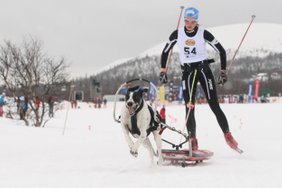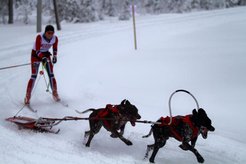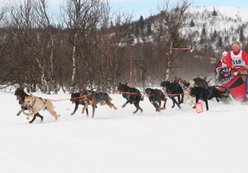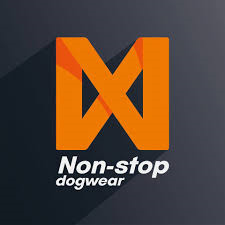About the sport
Team Racedogs
All rights reserved Team Racedogs
THE THREE BRANCHES OF DOGMUSHING
In modern times we divide the sport of dogmushing in three different branches; Nordic style (ski), Nome style (sled) and Dryland.
Nordic style
Nordic style is the branch of dogmushing where the human athlete compete on skis behind the canine athlete(s) - the dog. In all forms of Nordic style we compete in skating/freestyle skiing.
Most of the competitions are with only one dog, but there are some few competitions where you compete with two or more dogs.
Most people compete with German shorthaired pointer, English pointer or greysther-mixes (German pointer, English pointer, greyhound or similar) at the top level in this branch.
Within Nordic style there is three different disciplines;
1. Pulka.
The pulka you see demonstrated on the picture above. The dog pulls the pulka, which by the rules has to weigh 70% of your dog's weight.
Normally this is an individual start race, and the standard distance is 10km for women, and 15km for men.
In Norway, every other year, we have Norwegian championship in 1-4dog pulka - meaning you can choose to compete with up to 4 dogs in front of the pulka, and of course adjust the weight thereafter.
2. Skijoring
In skijoring there is only a line between you and your dog. Here we normally compete with 1 or 2 dogs.
3. Combined
This form of competition is a combination between the two above. This is almost exclusively mass start, where you start with the pulka and halfway through the race you go through a pit-stop where you detach the pulka and continue with just a line (skijoring). This race is probably the most exciting race for spectators to watch as there is more action and more of a "stadium sport".
Nome style
Nome style is the most known branch for dogmushing worldwide, and mostly the only one people know about. This is where the human athlete is standing/kicking/running on a sled while 4-16 dogs are running in front pulling the sled.
What is so special about nome style is that women and men are equal, and compete against each other on the same terms.
This branch can be divided into three disciplines;
1. Long-distance
These races normally go over several days, with distances from 150km to the longest 1600km - which is the Iditarod.
The team has to manage more or less on it's own during the race, and it takes a strong mentality and physical endurance to be able just to finish many of these races.
For these races you need dogs with stamina and good fur to endure the cold. Most people race with Alaskan huskies, some use pure breed like Siberian huskies.
2. Mid-distance
In mid-distance the teams race between 25-100km a day, and mostly over at least 2-3days+. Stage races are very normal here, like the NorwayTrail.
The dogs being used in these competitions are mostly Alaskan huskies, but with more speed and strength qualities like the sprint dogs - and with less fur than the long-distance dogs*.
3. Sprint
Sprint is the Formula1 of nome style. Here they compete over 5-25km, depending on how many dogs they have in front of the sled. The classes are 4-dog, 6-dog, 8-dog and 12-dog, and they normally compete 2-3days in a row with overall results.
It is normal to use same dogs as in Nordic style, and alaskan huskies breeded for sprint.
The picture on top is from when I tested my sled skills in the Norwegian championship in sprint in 2013. The conclusion was that my sled skills were not that good...
* Alaskan husky is not an approved breed, and the specimens vary a lot (!). The Alaskan is a mix between different breeds to obtain different qualities for the various races.
Dryland
Dryland is all the different classes we compete in on, guess what, dryland!
Here you find;
- Bikejoring; cycling with one dog in front, like illustrated on the picture above
- Canicross; running with one dog pulling you
- Scooter 1- and 2-dog; kickbike with one or two dogs in front, gender equal - men and women compete side by side.
- 4-dog, 6-dog and 8-dog; the set amount of dogs pulling a wagon while you stand/kick/run on it.
Traditionally people compete with the same dogs as they use in Nordic style and nome style sprint, but more and more people are competing with all kinds of dogs in this branch of dogmushing.
Competition trails for bikejoring, scooter and wagon is between 4-8km, while they usually run between 3-5km in canicross.
With up to and more than 500 athletes competing in the world championship on dryland this branch is also the fastest growing, and the championships tend to gather more competitors than the winter disciplines.
“Racedogs.no” 2016.
Unauthorized use and/or duplication of this material without express and written permission from this website’s author and/or owner is strictly prohibited.
HAKLE AS









